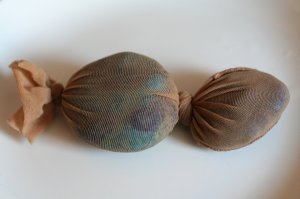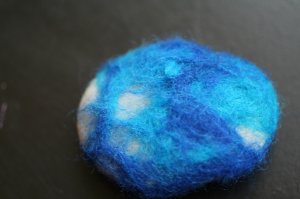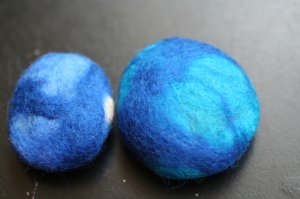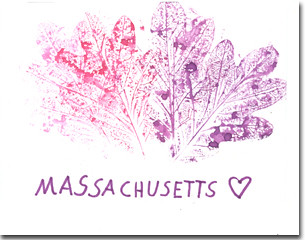How-To IKEA Hack: Circular Bulletin Boards
Sometimes you need a quick and easy handmade gift (or to restyle your own desk or studio space), so here is a simple IKEA hack that takes less than an hour and under $5.
Trivet to Bulletin Board

You will need:
IKEA's "Heat" Trivets ($2.99 for the set)
Attractive flat thumbtacks
Scrap fabric larger than the trivets
Glue (I used Magna-Tac, but Tacky glue or hot glue would be good choices)
A drill with large drill bit
 First, drill a large hole in each piece of cork about 1" from the edge. These holes need to be large enough for hanging your finished board by either a nail or a push pin.
First, drill a large hole in each piece of cork about 1" from the edge. These holes need to be large enough for hanging your finished board by either a nail or a push pin.
 Next, push your thumbtacks through the fabric along the narrow edge of the cork. Pull the fabric as you go to make a taut and smooth surface on the face of the bulletin board. You will get the best results if you add the tacks evenly with each tack opposite to the one you put before (see example starting order below).
Next, push your thumbtacks through the fabric along the narrow edge of the cork. Pull the fabric as you go to make a taut and smooth surface on the face of the bulletin board. You will get the best results if you add the tacks evenly with each tack opposite to the one you put before (see example starting order below).
 Fill in this pattern until your edge is completely covered with thumbtacks.
Fill in this pattern until your edge is completely covered with thumbtacks.
 At this point, your bulletin boards should look like this.
At this point, your bulletin boards should look like this.
 Flip over your bulletin board, and trim excess fabric to about 1" all the way around.
Flip over your bulletin board, and trim excess fabric to about 1" all the way around.
 Glue down the excess fabric around the back. Allow to dry.
Glue down the excess fabric around the back. Allow to dry.
 You're finished! Here are the three coordinating bulletin boards I made for this tutorial.
You're finished! Here are the three coordinating bulletin boards I made for this tutorial.
 Hope you enjoy making this quick project, and please link to photos of your finished bulletin boards or comment to share variations that you come up with.
Hope you enjoy making this quick project, and please link to photos of your finished bulletin boards or comment to share variations that you come up with.
 ~Kari
~Kari
http://ikyoto.etsy.com
Trivet to Bulletin Board

You will need:
IKEA's "Heat" Trivets ($2.99 for the set)
Attractive flat thumbtacks
Scrap fabric larger than the trivets
Glue (I used Magna-Tac, but Tacky glue or hot glue would be good choices)
A drill with large drill bit
 First, drill a large hole in each piece of cork about 1" from the edge. These holes need to be large enough for hanging your finished board by either a nail or a push pin.
First, drill a large hole in each piece of cork about 1" from the edge. These holes need to be large enough for hanging your finished board by either a nail or a push pin. Next, push your thumbtacks through the fabric along the narrow edge of the cork. Pull the fabric as you go to make a taut and smooth surface on the face of the bulletin board. You will get the best results if you add the tacks evenly with each tack opposite to the one you put before (see example starting order below).
Next, push your thumbtacks through the fabric along the narrow edge of the cork. Pull the fabric as you go to make a taut and smooth surface on the face of the bulletin board. You will get the best results if you add the tacks evenly with each tack opposite to the one you put before (see example starting order below). Fill in this pattern until your edge is completely covered with thumbtacks.
Fill in this pattern until your edge is completely covered with thumbtacks. At this point, your bulletin boards should look like this.
At this point, your bulletin boards should look like this. Flip over your bulletin board, and trim excess fabric to about 1" all the way around.
Flip over your bulletin board, and trim excess fabric to about 1" all the way around. Glue down the excess fabric around the back. Allow to dry.
Glue down the excess fabric around the back. Allow to dry. You're finished! Here are the three coordinating bulletin boards I made for this tutorial.
You're finished! Here are the three coordinating bulletin boards I made for this tutorial. Hope you enjoy making this quick project, and please link to photos of your finished bulletin boards or comment to share variations that you come up with.
Hope you enjoy making this quick project, and please link to photos of your finished bulletin boards or comment to share variations that you come up with. ~Kari
~Karihttp://ikyoto.etsy.com































